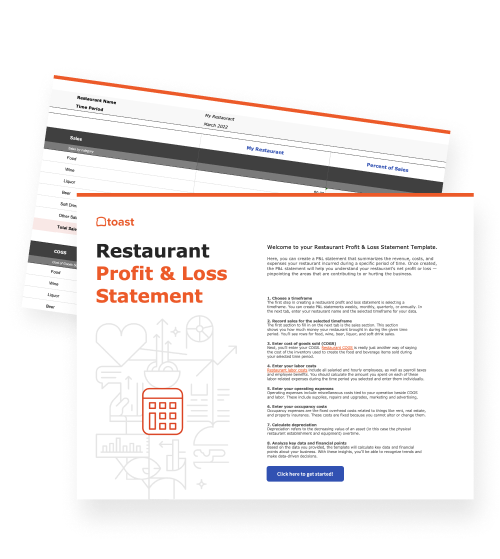
The Most Important Restaurant Financial Statements
Here are some of the standard financial statements restaurant owners should keep an eye on.
Brian ChoAuthor


Restaurant Profit and Loss Statement Template
Evaluate your restaurant's financial strengths and weaknesses with the free P&L and income statement template.
Get free downloadRestaurant owners may think that they know their business inside and out: they know exactly what today’s specials are, which ingredients they’re starting to run low on, and the names of their most faithful repeat customers. However, the less glamorous side of the business involves one of the most important pulse checks on their restaurants’ health: analyzing their restaurant financial statements. Often offloaded to accountants or, in the case of larger chains, CFOs, financial statements of a restaurant might not be the most appealing reading material for a restaurant owner or GM focused on day-to-day operations, and understandably so.
Despite that, knowing how to read restaurant monthly financial statements remains a critical next step to enable restaurant operator to gain a holistic understanding of how their business is performing. Restaurant financial statements tie together daily operations with financial performance, providing critical context behind how a restaurant is actually doing while helping to alert restaurateurs to concerning or inefficient aspects of their business.
In this article, we’ll go over standard financial statements restaurant owners should keep an eye on. These are often referred to in the finance world as “the three statements” — the income statement, balance sheet, and cash flow statements. Each statement ties to the others in one way or another, but we won’t get into the nuts and bolts in this article. You can see some restaurant financial statement examples by looking at our income statement and balance sheet templates.
Take a seat, grab your calculator, and learn about how these statements can give you a new perspective into your business’ health.
Income statement
The income statement (also known as a profit and loss statement, abbreviated as P&L) is one of the bread and butter standard financial statements that restaurant owners are familiar with. Income statements can present information in a few different ways, but always tells you how much revenue you made, what expenses you paid, and how much profit you collected within a specific time period. Looking at your income statement on a monthly, quarterly, and yearly basis can help you keep a pulse on your restaurant’s performance, especially when comparing these periods to the same periods in prior years.
As mentioned above, income statements can be presented in a few different ways, but there are a couple of primary formats an income statement can come in. They all begin with your revenue, or sales, before moving onto different categories of expenses — the most common of which is called your cost of goods sold, or COGS, which is typically food and beverage costs. Another helpful restaurant financial metric is prime cost, which is essentially your COGS plus your total labor costs, which can help you get a full picture of your input costs, or direct costs, of producing your restaurant’s meals.
Beyond that, it’s important to choose a categorization structure for your expenses because it will help you make sense of where you’re spending your money, especially when comparing across periods. For example, you could have major categories of variable vs. fixed expenses, which helps to separate your operating expenses into costs that fluctuate (such as wages) or stay constant (such as rent). A small restaurant’s financial statements are significantly easier to parse and understand thanks to its smaller scale, but in preparation for growth and expansions, it’s still recommended to carefully track your revenue and expenses by assigning them to easy-to-understand categories.
Types of profit
After digging into your income statement a bit, you’ll come across a few profit line items, which you can turn into percentages (margins) to help with comparisons:
Gross profit: this is your revenue minus your COGS, which tells you how much money you’re keeping from your sales after factoring in the costs of ingredients and related expenses. When you divide this by your revenue, you get your gross margin.
Operating profit: this is your gross profit minus all operating expenses (which excludes interest and tax expenses). This tells you how much money you made as part of your true operations, before you factor in any interest or taxes. Dividing this by your revenue gets you your operating margin.
Net profit: this is your real “bottom line” after every expense is paid, including interest and taxes. Dividing this by your revenue results in your net profit margin.
Types of growth and margins
Now that you’ve gotten a sense of what an income statement is, what can you do with it? For starters, you can begin comparing and benchmarking some restaurant performance metrics to that of previous periods. The best way to do this is to start putting things into percentages, such as growth and margin, to get an apples-to-apples view into everything you want to dig into.
Revenue growth: used to compare your revenue from a specific period to the same period from the previous year, which helps you get a grasp of how fast or slow your restaurant is growing its sales. If your restaurant is not seasonal, you can also analyze your month-over-month revenue growth trends.
Margins: compare the margins we described above to help see how your profitability compares across periods.
Specific expenses or COGS as a percent of total expenses or COGS: on a standalone basis, this ratio helps you understand where your major expenses are, potentially letting you identify areas where you should negotiate better pricing or find a comparable product to replace the item with. You can also compare this across periods to see which costs are rising as a percent of revenue.
Maybe, for example, you saw a drop in gross margin; think about what caused it: did your ingredient costs go up, did you discount your dishes, did you give out too many comps? Maybe the extra expenses helped you grow your revenue more and let you build up a bigger customer base, which can help increase margins in future periods. Once you put the pieces together and do some reverse-engineering, you’ll get a much better sense of how your restaurant is performing.
Let’s say everything looks great on your income statement — nothing to worry about then, right?
Not necessarily... Remember that there are three major restaurant financial statements, and each one plays an important role!
Balance sheet
The second of the big three restaurant financial statements is called the balance sheet. The balance sheet consists of three major categories: assets, liabilities, and equity (also referred to as owner’s or shareholders’ equity), each of which contain various line items with dollar values as they stand at a specific snapshot in time; for example, a year-end balance sheet will house values as they stand on December 31st.
Total assets equals total liabilities plus equity, which is why it’s referred to as a “balance sheet.” Many insights from the balance sheet are actually uncovered in the cash flow statement, which we will talk about next. However, the balance sheet is very useful for digging into thanks to the various helpful ratios you can calculate from it.
Key restaurant balance sheet ratios
Current ratio (current assets / current liabilities): this ratio basically tells you the ratio of dollars you have in current assets that can be used to pay off your current liabilities. Ideally, this ratio is above 1.0, which would imply that you can cover all your current liabilities by liquidating your current assets. However, if the ratio is too high, it may mean you aren’t employing your short-term capital enough to grow your restaurant.
Inventory turnover (COGS / average of starting inventory and ending inventory): this ratio basically tells you how much you are “turning over” your inventory when making sales. For restaurants, the ideal ratio depends on how much fresh food you keep as inventory and could range from a few days to a week. A high inventory turnover ratio could mean high sales flow, but may also imply you’re not holding enough inventory on hand, while a low inventory turnover may point to an overstock of purchases, a slowdown in sales, or potential risks of spoilage.
Debt-to-equity ratio (total liabilities / total equity): this ratio helps you assess your restaurant’s financial health based on its current capital structure. There is a careful balance in play here — a ratio that is low may be considered “safe” but a ratio that’s too low may present an opportunity for growth by undertaking more liabilities or debt; on the flip side, a ratio that is high is generally viewed unfavorably as a business that is over-encumbered with liabilities or overleveraged.
Balance Sheet Template
This template will help you forecast short and long-term cash flow and assess the overall financial health of your restaurant.

The importance of a POS with great reporting functionality
You’ve made it to the end of the article — there’s a lot to take in when it comes to restaurant financial statements, and we’ve somehow only just scratched the surface. With all these ratios, margins, and profits floating around, the last thing you want to have to worry about is getting your sales data into your accounting system. That’s why it’s massively important to select a POS partner with strong integrations, especially if you have an existing accounting system because switching accounting software can be a huge pain that comes with a very steep learning curve.
Beyond strong integrations that can automate the flow of your sales and other POS data into your accounting system, look out for a POS partner that can provide you with deep-level reporting on your POS data. This could range from in-depth breakdowns of your sales over time, which menu items are performing or struggling, and even help you compare your performance across multiple locations that you operate. Don’t skimp on the quality of your POS partner, because a broken integration can easily come back to haunt you, costing significant time and money to fix or replace.
Time to Crunch the Numbers
With all this newfound knowledge, you’re now better equipped to understand every aspect of your business. During end-of-month activities, you can now take the time to sit down with your accountant or CFO and get involved with understanding your restaurant’s performance and formulate an action plan to optimize your sales, expenses, and cash flow.
Is this article helpful?
DISCLAIMER: This information is provided for general informational purposes only, and publication does not constitute an endorsement. Toast does not warrant the accuracy or completeness of any information, text, graphics, links, or other items contained within this content. Toast does not guarantee you will achieve any specific results if you follow any advice herein. It may be advisable for you to consult with a professional such as a lawyer, accountant, or business advisor for advice specific to your situation.
Read More
Subscribe to On the Line
Sign up to get industry intel, advice, tools, and honest takes from real people tackling their restaurants’ greatest challenges.



